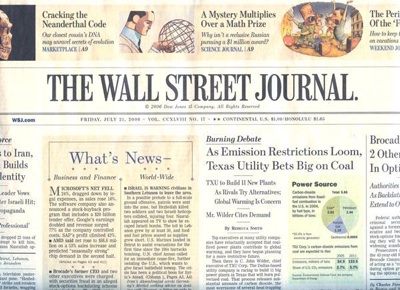Non-Commodificable in Newsprint
A followup on my Better Than Free, which concern things which could not be easily copied. Michael Hirschorn, writing in the Atlantic, muses on whether newspapers have to be boring in order to survive. He compares what newspapers think is important — what they put on the front page — with what readers think is interesting — what articles they forward to friends.
I reviewed a week’s worth of front pages of The Washington Post, The Los Angeles Times, and The New York Times in September and compared them with each day’s most–e-mailed list. I had expected the most–e-mailed results to track the lineups of the more baldly audience-focused TV newscasts, which have increasingly made a fetish of “news that matters to you,” and hence are packed with tedious features on your health, your real estate, your job, your children, and so forth.
In other words, that’s the conventional wisdom about newsy stuff: There’s the boring important things on the front page and the frivolous self-help stuff on the rest. What Hirschorn found in his study was different:
Instead, the most–e-mailed lists, despite a smattering of parochial concerns, were a rich stew of global affairs, provocative insight, hot-button issues, pop culture, compelling narrative, and enlightened localism. In short, they were interesting. What they were not, generally, was important, at least not in the grand tectonic geopolitical sense.
The boring news — most of it “important” — is now a commodity, easily found and replicated. Hirschorn continues:
The real value now lies in non-commodificable virtues like deep reporting, strong narrative, distinct point of view, and sharp analysis, which even in the blogger era (or especially in the blogger era) is available only piecemeal.

He points to several examples of newspapers who are emphasizing the non-commodificable virtues, which are closely aligned with my non-copiable generatives. As one example he suggests the front page of the Wall Street Journal (not freely online, at the moment).
The Journal, as a business paper, has been using its front-page news digest to dispense with commodity news for decades, while employing its valuable real estate to pinpoint trends, elevate key personalities, and, with the lighter middle-column stories, reinforce its brand of wry amusement at the capitalist carnival.
I agree with this. The front page of the WSJ was always my favorite, pursuing novel subjects in depth, yet being relevant in unusual ways. The virtues folks want from newspapers are, he says:
…a high-low mix of agenda-setting reportage and analysis, strong storytelling on topics not being covered everywhere else, and saucy, knowing takeouts on people the readership actually cares about.


